Improvement in the Modeled Representation of North American Monsoon Precipitation Using a Modified Kain–Fritsch Convective Parameterization Scheme
Abstract
:1. Introduction
2. Data Analysis and Methods
2.1. Overview of NAME Intensive Observing Period 2
2.2. Regional Atmospheric Model Simulation Design for NAME IOP 2
2.3. Observational Data
2.4. Regional Climate Model Simulation
2.5. Modifying the Kain–Fritsch CPS to Account for Vertical Dynamic Pressure Effects
- The modified CAPE within an updraft source layer must be positive in order to support convection
- There must be positive modified CAPE within an updraft source layer (USL) that is sufficient to overcome any convective inhibition through the depth of the USL to the lifting condensation level.
3. Evaluation of the Modified KF CPS for the Vietnam Case in WRF
4. Application of the Modified KF CPS in WRF Simulation of NAME IOP2
4.1. Review of Meteorological Conditions during NAME IOP2
4.2. Model Representation of the Gulf Surge
4.3. Cross Sectional Analysis of Condensate Mixing Ratio at High Temporal Resolution
4.4. Differences in Model Simulated Precipitation and Comparison with Observations
5. Value Added in a Regional Climate Modeling Experiment
5.1. Changes in Model-Simulated Monsoon Precipitation in the 60-Year RCM Experiment
5.2. Simulating Extreme Weather Events at Convective-Permitting Scales
6. Summary and Discussion
Acknowledgments
Author Contributions
Conflicts of Interest
References
- Castro, C.L.; Pielke, R.A.; Adegoke, J.O. Investigation of the summer climate of the contiguous United States and Mexico using the regional atmospheric modeling system (RAMS). Part 1: Model climatology (1950–2002). J. Clim. 2007, 20, 3844–3865. [Google Scholar] [CrossRef]
- Finch, Z.O.; Johnson, R.H. Observational analysis of an upper-level inverted trough during the 2004 North American Monsoon Experiment. Mon. Weather Rev. 2010, 138, 3540–3555. [Google Scholar] [CrossRef]
- Newman, A.; Johnson, R.H. Mechanisms for precipitation enhancement in a North American monsoon upper-tropospheric trough. J. Atmos. Sci. 2012, 69, 1775–1792. [Google Scholar] [CrossRef]
- Watson, A.I.; Lopez, R.E.; Holle, R.L. Diurnal cloud-to-ground lightning patterns in Arizona during the southwest monsoon. Mon. Weather Rev. 1994, 122, 1716–1725. [Google Scholar] [CrossRef]
- Douglas, M.W.; Maddox, R.A.; Howard, K.; Reyes, S. The Mexican monsoon. J. Clim. 1993, 6, 1665–1677. [Google Scholar] [CrossRef]
- Adams, D.K.; Comrie, A.C. The North American monsoon. Bull. Am. Meteorol. Soc. 1997, 78, 2197–2213. [Google Scholar] [CrossRef]
- Ray, A.J.; Garfin, G.M.; Wilder, M.; Vasquez-Leon, M.; Lenart, M.; Comrie, A.C. Applications of monsoon research: Opportunities to inform decision making and reduce regional vulnerability. J. Clim. 2007, 20, 1608–1627. [Google Scholar] [CrossRef]
- Pytlak, E.; Goering, M.; Bennett, A. Upper tropospheric troughs and their interaction with the North American monsoon. In Proceedings of the 19th Conference in Hidrology AMS, San Diego, CA, USA, 9–13 January 2005. [Google Scholar]
- Bieda, S.W.; Castro, C.L.; Mullen, S.L.; Comrie, A.C.; Pytlak, E. The relationship of transient upper-level troughs to variability of the North American monsoon system. J. Clim. 2009, 22, 4213–4227. [Google Scholar] [CrossRef]
- Seastrand, S.; Serra, Y.; Castro, C.; Ritchie, E. The dominant synoptic-scale modes of North American monsoon precipitation. Int. J. Climatol. 2015, 35, 2019–2032. [Google Scholar] [CrossRef]
- Lahmers, T.M.; Castro, C.L.; Adams, D.K.; Serra, Y.L.; Brost, J.J.; Luong, T. Long-term changes in the climatology of transient inverted troughs over the North American monsoon region and their effects on precipitation. J. Clim. 2016, 29, 6037–6064. [Google Scholar] [CrossRef]
- Pielke, R.A.; Pearce, R.P. Mesoscale Modeling of the Atmosphere. Meteorological Monographs; Springer: Berlin, Germany, 1994; Volume 25, pp. 1–167. [Google Scholar]
- Janowiak, J.E.; Dagostaro, V.J.; Kousky, V.E.; Joyce, R.J. An examination of precipitation in observations and model forecasts during name with emphasis on the diurnal cycle. J. Clim. 2007, 20, 1680–1692. [Google Scholar] [CrossRef]
- Smith, W.P.; Gall, R.L. Tropical squall lines of the Arizona monsoon. Mon. Weather Rev. 1989, 117, 1553–1569. [Google Scholar] [CrossRef]
- McCollum, D.M.; Maddox, R.A.; Howard, K.W. Case-study of a severe mesoscale convective system in central Arizona. Weather Forecast. 1995, 10, 643–665. [Google Scholar] [CrossRef]
- Douglas, M.W. The summertime low-level jet over the gulf of California. Mon. Weather Rev. 1995, 123, 2334–2347. [Google Scholar] [CrossRef]
- Zehnder, J.A. Dynamic mechanisms of the gulf surge. J. Geophys. Res. Atmos. 2004, 109. [Google Scholar] [CrossRef]
- Schiffer, N.J.; Nesbitt, S.W. Flow, moisture, and thermodynamic variability associated with gulf of California surges within the North American monsoon. J. Clim. 2012, 25, 4220–4241. [Google Scholar] [CrossRef]
- Rotunno, R.; Klemp, J.B.; Weisman, M.L. A theory for strong, long-lived squall lines. J. Atmos. Sci. 1988, 45, 463–485. [Google Scholar] [CrossRef]
- Lang, T.J.; Ahijevych, D.A.; Nesbitt, S.W.; Carbone, R.E.; Rutledge, S.A.; Cifelli, R. Radar-observed characteristics of precipitating systems during name 2004. J. Clim. 2007, 20, 1713–1733. [Google Scholar] [CrossRef]
- Castro, C.L.; Chang, H.I.; Dominguez, F.; Carrillo, C.; Schemm, J.K.; Juang, H.M.H. Can a regional climate model improve the ability to forecast the North American monsoon? J. Clim. 2012, 25, 8212–8237. [Google Scholar] [CrossRef]
- Collier, J.C.; Zhang, G.J. Effects of increased horizontal resolution on simulation of the North American monsoon in the NCAR CAM3: An evaluation based on surface, satellite, and reanalysis data. J. Clim. 2007, 20, 1843–1861. [Google Scholar] [CrossRef]
- Lee, M.I.; Schubert, S.D.; Suarez, M.J.; Held, I.M.; Lau, N.C.; Ploshay, J.J.; Kumar, A.; Kim, H.K.; Schemm, J.K.E. An analysis of the warm-season diurnal cycle over the continental United States and Northern Mexico in general circulation models. J. Hydrometeorol. 2007, 8, 344–366. [Google Scholar] [CrossRef]
- Nesbitt, S.W.; Gochis, D.J.; Lang, T.J. The diurnal cycle of clouds and precipitation along the sierra madre occidental observed during name-2004: Implications for warm season precipitation estimation in complex terrain. J. Hydrometeorol. 2008, 9, 728–743. [Google Scholar] [CrossRef]
- Cassell, W.W.; Castro, C.L.; Luong, T.M.; Arellano, A. Simulating organized convection during the 2004 north american monsoon experiment and its sensitivity to the specification of initial conditions. Atmósfera 2017. Sumitted. [Google Scholar]
- Li, J.; Sorooshian, S.; Higgins, W.; Gao, X.; Imam, B.; Hsu, K. Influence of spatial resolution on diurnal variability during the North American monsoon. J. Clim. 2008, 21, 3967–3988. [Google Scholar] [CrossRef]
- Klemp, J.B.; Wilhelmson, R.B. Simulation of 3-dimensional convective storm dynamics. J. Atmos. Sci. 1978, 35, 1070–1096. [Google Scholar] [CrossRef]
- Klemp, J.B.; Wilhelmson, R.B. Simulations of right-moving and left-moving storms produced through storm splitting. J. Atmos. Sci. 1978, 35, 1097–1110. [Google Scholar] [CrossRef]
- Finley, C.A.; Cotton, W.R.; Pielke, R.A. Numerical simulation of tornadogenesis in a high-precipitation supercell. Part I: Storm evolution and transition into a bow echo. J. Atmos. Sci. 2001, 58, 1597–1629. [Google Scholar] [CrossRef]
- Cai, H.Q.; Wakimoto, R.M. Retrieved pressure field and its influence on the propagation of a supercell thunderstorm. Mon. Weather Rev. 2001, 129, 2695–2713. [Google Scholar] [CrossRef]
- Xu, K.M.; Randall, D.A. Updraft and downdraft statistics of simulated tropical and midlatitude cumulus convection. J. Atmos. Sci. 2001, 58, 1630–1649. [Google Scholar] [CrossRef]
- Doyle, J.D.; Durran, D.R. The dynamics of mountain-wave-induced rotors. J. Atmos. Sci. 2002, 59, 186–201. [Google Scholar] [CrossRef]
- Chu, C.M.; Lin, Y.L. Effects of orography on the generation and propagation of mesoscale convective systems in a two-dimensional conditionally unstable flow. J. Atmos. Sci. 2000, 57, 3817–3837. [Google Scholar] [CrossRef]
- Chen, S.H.; Lin, Y.L. Effects of moist froude number and cape on a conditionally unstable flow over a mesoscale mountain ridge. J. Atmos. Sci. 2005, 62, 331–350. [Google Scholar] [CrossRef]
- Grabowski, W.W.; Smolarkiewicz, P.K. CRCP: A cloud resolving convection parameterization for modeling the tropical convecting atmosphere. Physica D 1999, 133, 171–178. [Google Scholar] [CrossRef]
- Grabowski, W.W. Coupling cloud processes with the large-scale dynamics using the cloud-resolving convection parameterization (CRCP). J. Atmos. Sci. 2001, 58, 978–997. [Google Scholar] [CrossRef]
- Randall, D.; Khairoutdinov, M.; Arakawa, A.; Grabowski, W. Breaking the cloud parameterization deadlock. Bull. Am. Meteorol. Soc. 2003, 84, 1547–1564. [Google Scholar] [CrossRef]
- Arakawa, A.; Schubert, W.H. Interaction of a cumulus cloud ensemble with large-scale environment. Part I. J. Atmos. Sci. 1974, 31, 674–701. [Google Scholar] [CrossRef]
- Elliott, E.J.; Yu, S.; Kooperman, J.; Morrison, H.; Wang, M.; Pritchard, M.S. Sensitivity of summer ensembles of fledgling superparameterized U.S. Mesoscale convective systems to cloud resolving model microphysics and grid configuration. J. Adv. Model. Earth Syst. 2016, 8, 634–649. [Google Scholar] [CrossRef]
- Kooperman, G.J.; Pritchard, M.S.; Somerville, R.C.J. Robustness and sensitivities of central U.S. Summer convection in the super-parameterized CAM: Multi-model comparison with a new regional EOF index. Geophys. Res. Lett. 2013, 40, 3287–3291. [Google Scholar] [CrossRef]
- Grabowski, W.W. An improved framework for superparameterization. J. Atmos. Sci. 2004, 61, 1940–1952. [Google Scholar] [CrossRef]
- Nguyen, M.T.; Tran, T.T.; Pielke, R.A.; Castro, C.L.; Leoncini, G. A modified Kain-Fritsch scheme and its application for the simulation of an extreme precipitation event in Vietnam. Mon. Weather Rev. 2009, 137, 766–789. [Google Scholar]
- Phan, V.T.; Ngo-Duc, T.; Ho, T.M.H. Seasonal and interannual variations of surface climate elements over Vietnam. Clim. Res. 2009, 40, 49–60. [Google Scholar] [CrossRef]
- Nguyen-Le, D.; Matsumoto, J.; Ngo-Duc, T. Onset of the rainy seasons in the eastern Indochina Peninsula. J. Clim. 2015, 38, 5645–5666. [Google Scholar] [CrossRef]
- Yokoi, S.; Matsumoto, J. Collaborative effects of cold surge and tropical depression-type disturbance on heavy rainfall in central Vietnam. Mon. Weather Rev. 2008, 136, 3275–3287. [Google Scholar] [CrossRef]
- Xu, H.; Xie, S.P.; Wang, Y.; Zhuang, W.; Wang, D. Orographic effects on south china sea summer climate. Meteorol. Atmos. Phys. 2008, 100, 275–289. [Google Scholar] [CrossRef]
- The North American Monsoon Experiment Website. Available online: http://catalog.eol.ucar.edu/name/catalog/missions.Html (accessed on 20 November 2017).
- Rogers, P.J.; Johnson, R.H. Analysis of the 13–14 July gulf surge event during the 2004 North American Monsoon Experiment. Mon. Weather Rev. 2007, 135, 3098–3117. [Google Scholar] [CrossRef]
- Skamarock, W.C. Coauthors. A Description of the Advanced Research WRF Version 3; NCAR Tech. Note NCAR/TN-475+STR; National Center for Atmospheric Research: Boulder, CO, USA, 2008; pp. 1–113. [Google Scholar]
- The UA-HAS Weather Forecast Website. Available online: http://www.atmo.arizona.edu/index.php?section=weather (accessed on 20 november 2017).
- Higgins, W.; Gochis, D.J. Synthesis of results from the North American Monsoon Experiment (NAME) process study. J. Clim. 2007, 20, 1601–1607. [Google Scholar] [CrossRef]
- Lin, Y.L.; Farley, R.D.; Orville, H.D. Bulk parameterization of the snow field in a cloud model. J. Clim. Appl. Meteorol. 1983, 22, 1065–1092. [Google Scholar] [CrossRef]
- Janjic, Z.I. The step-mountain eta coordinate model—Further developments of the convection, viscous sublayer, and turbulence closure schemes. Mon. Weather Rev. 1994, 122, 927–945. [Google Scholar] [CrossRef]
- Tewari, M.; Chen, F.; Wang, W.; Dudhia, J.; LeMone, M.A.; Mitchell, K.; Ek, M.; Gayno, G.; Wegiel, J.; Cuenca, R.H. Implementation and verification of the unified NOAH land surface model in the WRF model. In Proceedings of the 20th Conference on Weather Analysis and Forecasting/16th Conference on Numerical Weather Prediction, Seattle, WA, USA, 14 January 2004; pp. 11–15. [Google Scholar]
- Iacono, M.J.; Delamere, J.S.; Mlawer, E.J.; Shephard, M.W.; Clough, S.A.; Collins, W.D. Radiative forcing by long-lived greenhouse gases: Calculations with the AER radiative transfer models. J. Geophys. Res. Atmos. 2008, 113. [Google Scholar] [CrossRef]
- Kain, J.S. The Kain-Fritsch convective parameterization: An update. J. Appl. Meteorol. 2004, 43, 170–181. [Google Scholar] [CrossRef]
- Castro, C.L.; Pielke, R.A.; Leoncini, G. Dynamical downscaling: Assessment of value retained and added using the regional atmospheric modeling system (RAMS). J. Geophys. Res. Atmos. 2005, 110. [Google Scholar] [CrossRef]
- Mesinger, F.; DiMego, G.; Kalnay, E.; Mitchell, K.; Shafran, P.C.; Ebisuzaki, W.; Jovic, D.; Woollen, J.; Rogers, E.; Berbery, E.H.; et al. North American regional reanalysis. Bull. Am. Meteorol. Soc. 2006, 87, 343–360. [Google Scholar] [CrossRef]
- Vose, R.S.; Applequist, S.; Squires, M.; Durre, I.; Menne, M.J.; Williams, C.N.; Fenimore, C.; Gleason, K.; Arndt, D. Improved historical temperature and precipitation time series for U.S. climate divisions. J. Appl. Meteorol. Clim. 2014, 53, 1232–1251. [Google Scholar] [CrossRef]
- Johnson, R.H.; Ciesielski, P.E.; McNoldy, B.D.; Rogers, P.J.; Taft, R.K. Multiscale variability of the flow during the North American Monsoon Experiment. J. Clim. 2007, 20, 1628–1648. [Google Scholar] [CrossRef]
- Ciesielski, P.E.; Johnson, R.H. Diurnal cycle of surface flows during 2004 NAME and comparison to model reanalysis. J. Clim. 2008, 21, 3890–3913. [Google Scholar] [CrossRef]
- Chang, H.I.; Castro, C.L.; Carrillo, C.M.; Dominguez, F. The more extreme nature of us warm season climate in the recent observational record and two “well-performing” dynamically downscaled CMIP3 models. J. Geophys. Res. Atmos. 2015, 120, 8244–8263. [Google Scholar] [CrossRef]
- Houze, R.A. Cloud Dynamics; Academic Press: San Diego, CA, USA, 1993; p. 573. [Google Scholar]
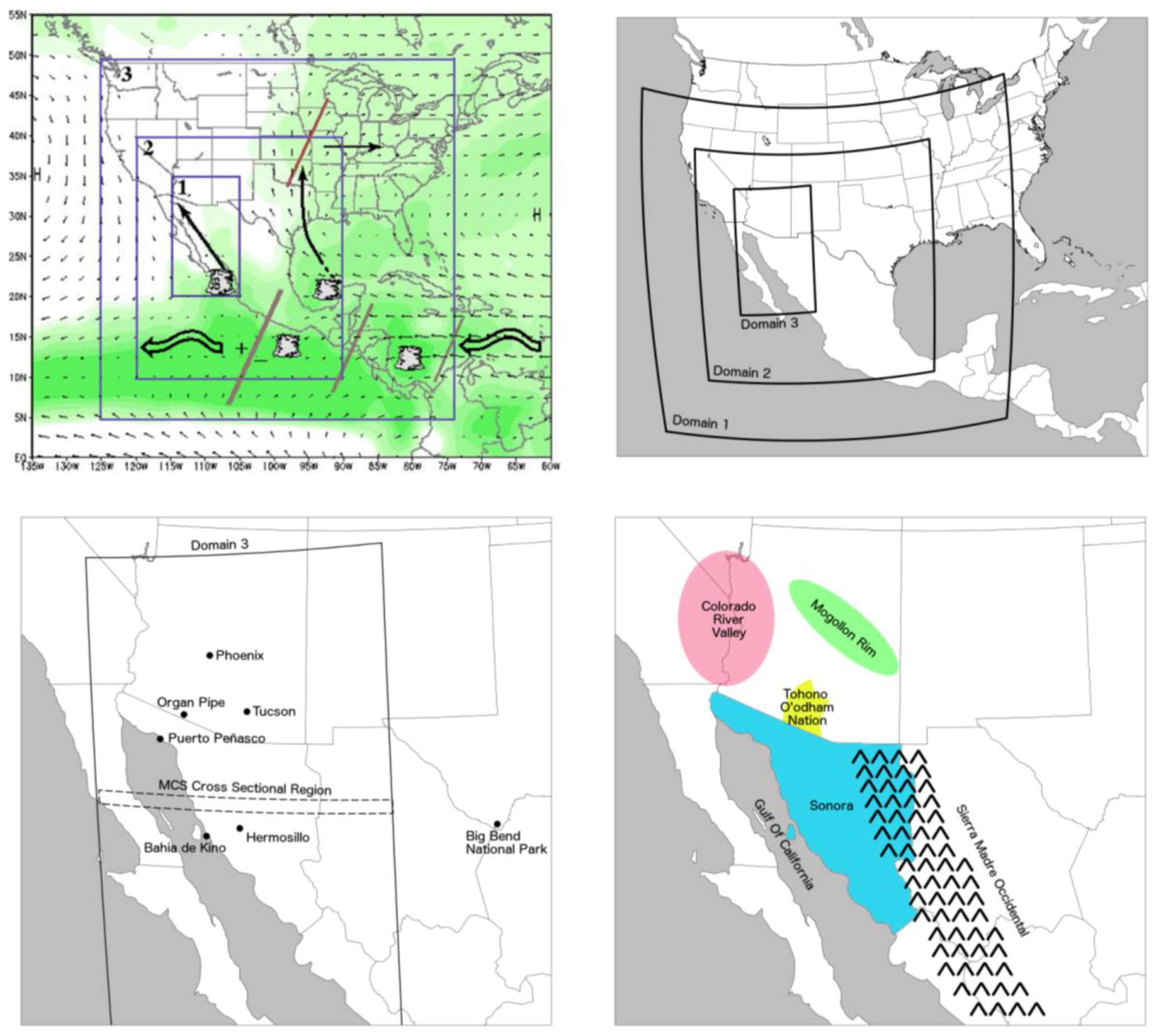
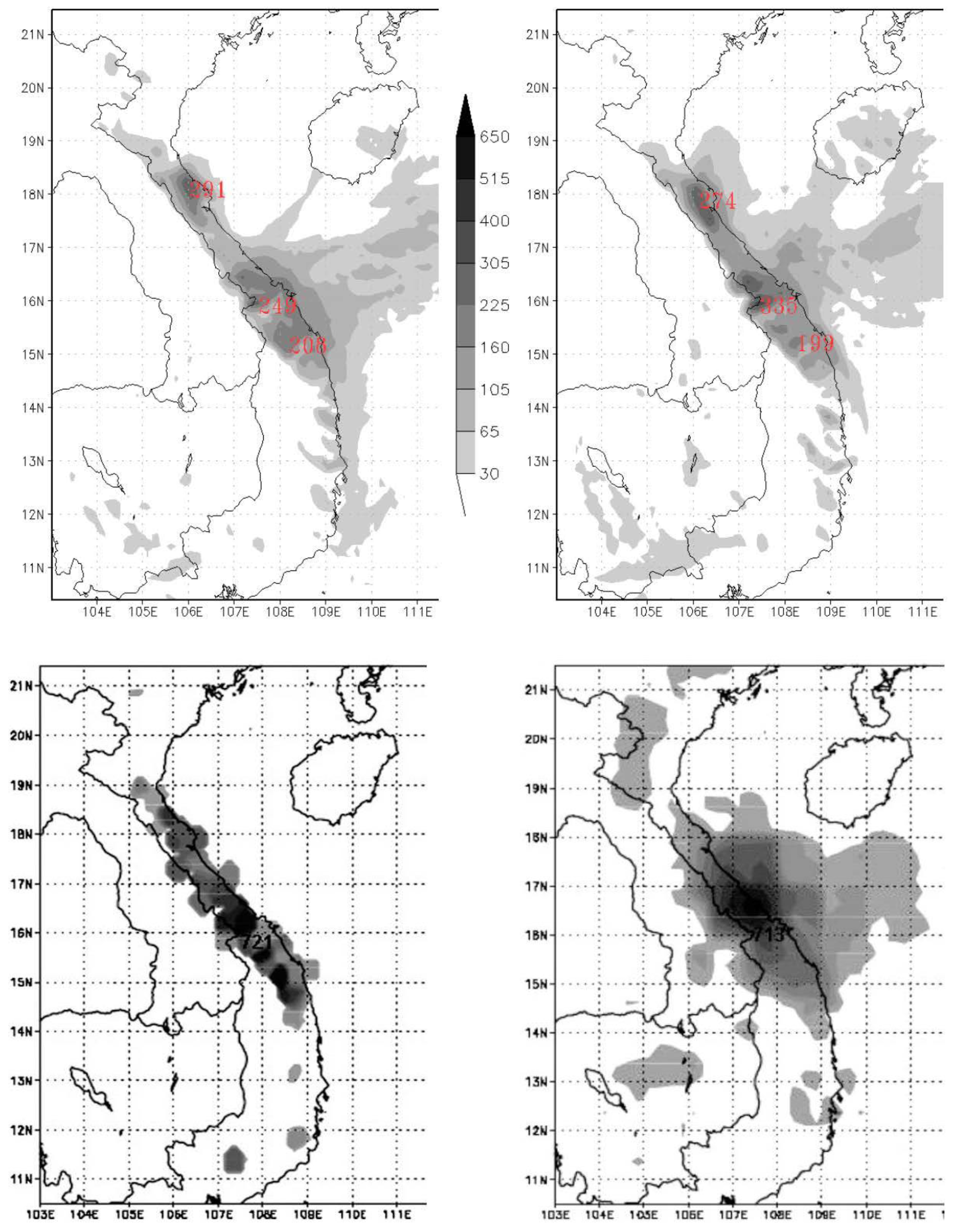
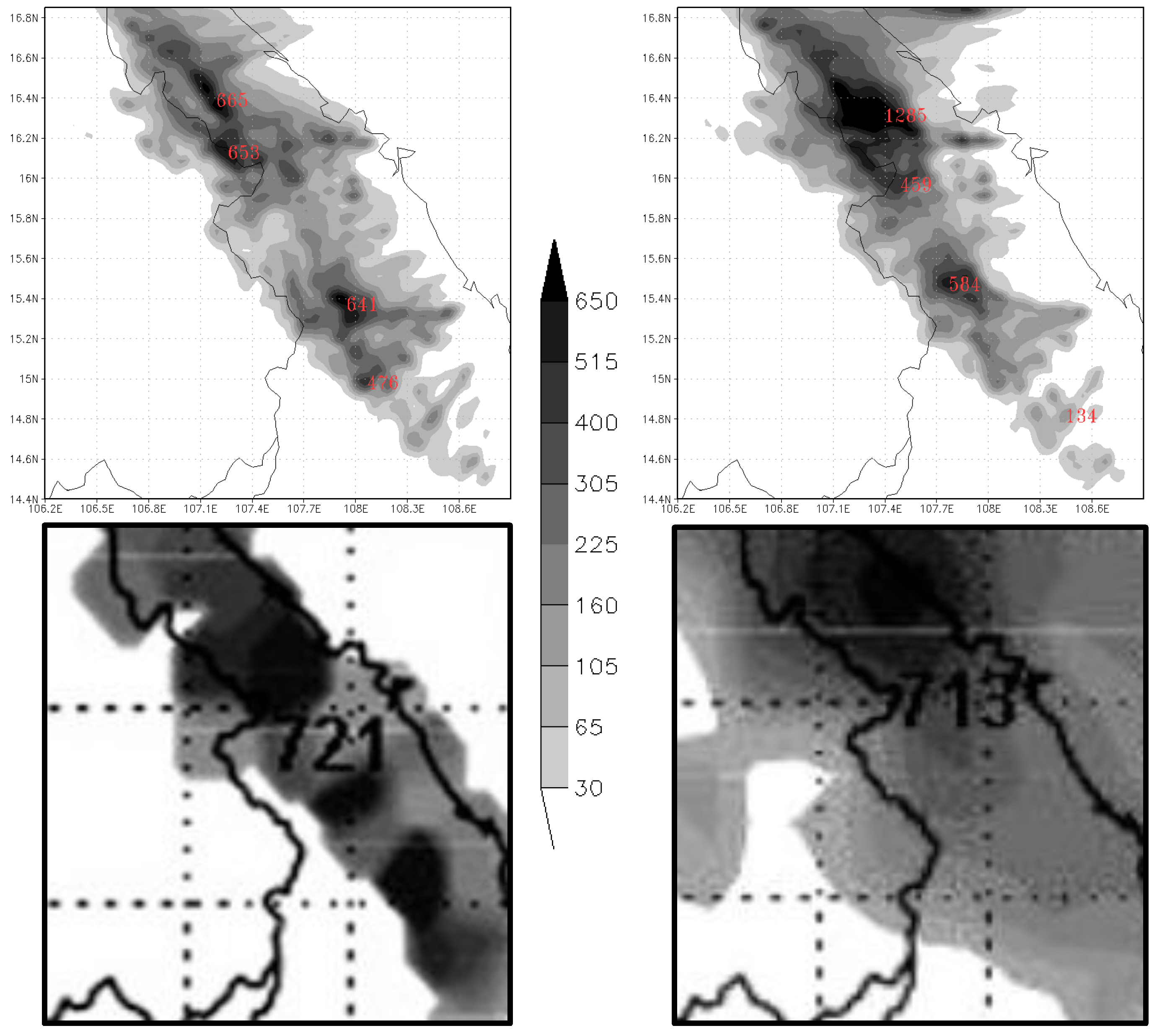
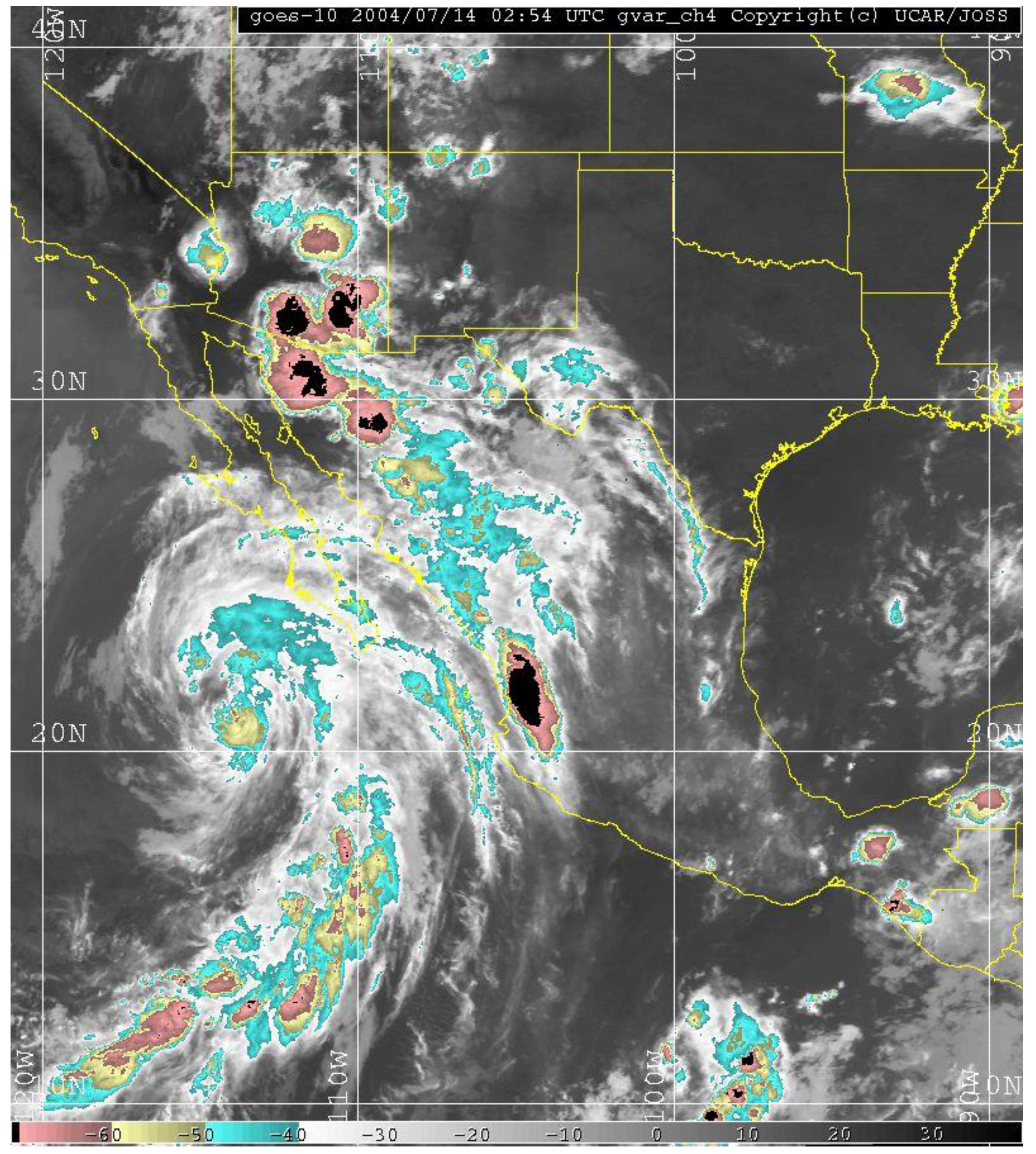
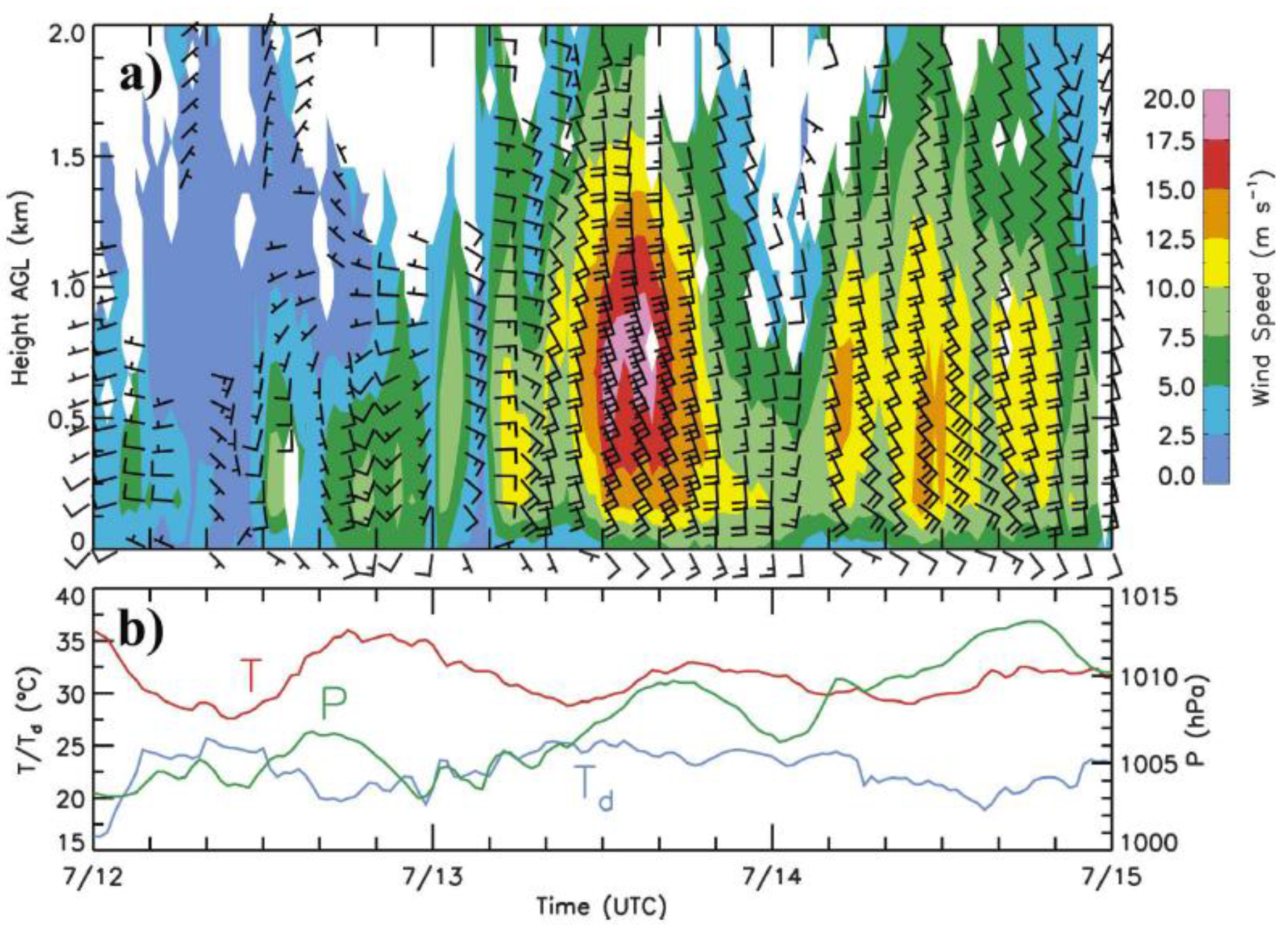
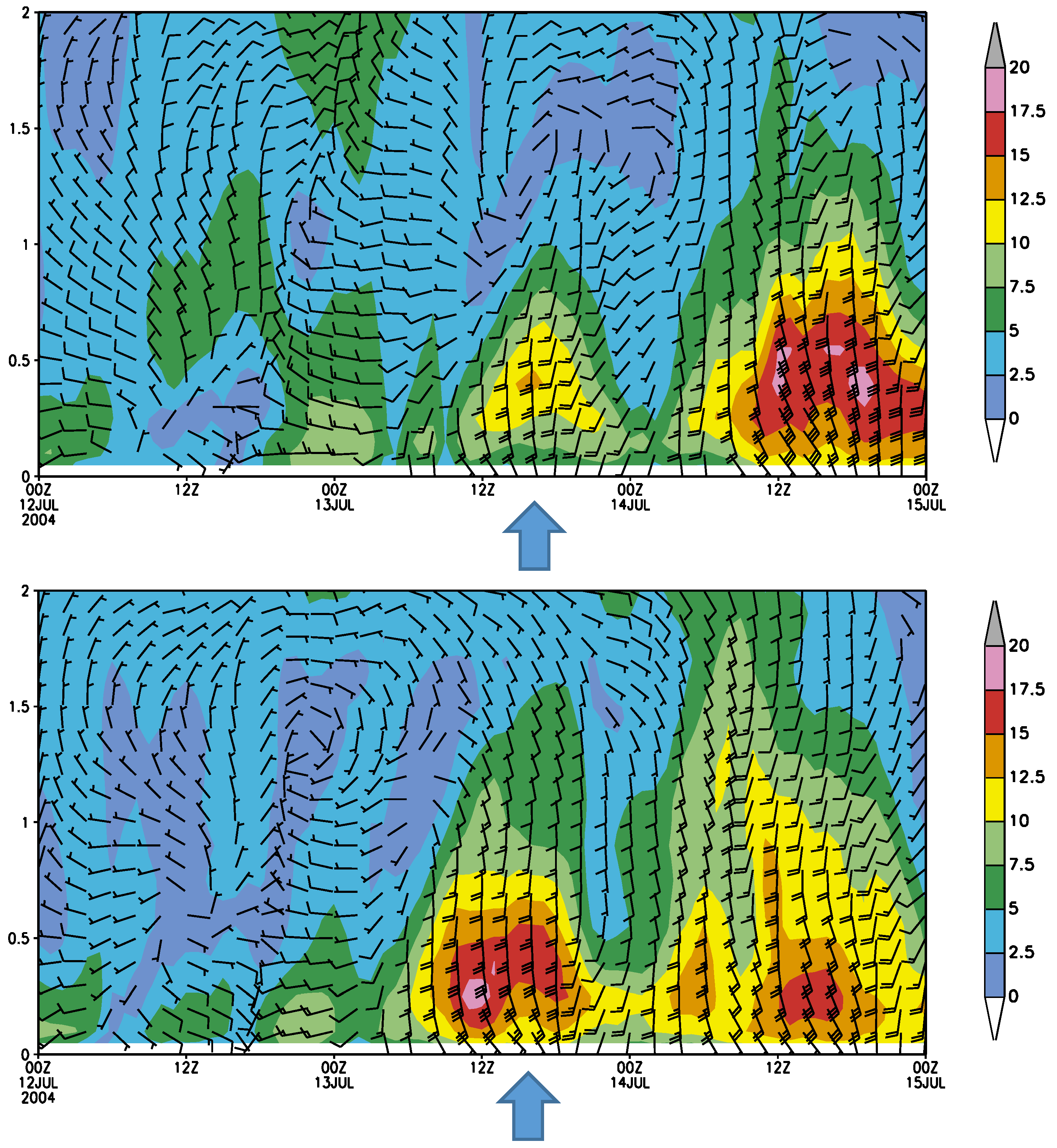
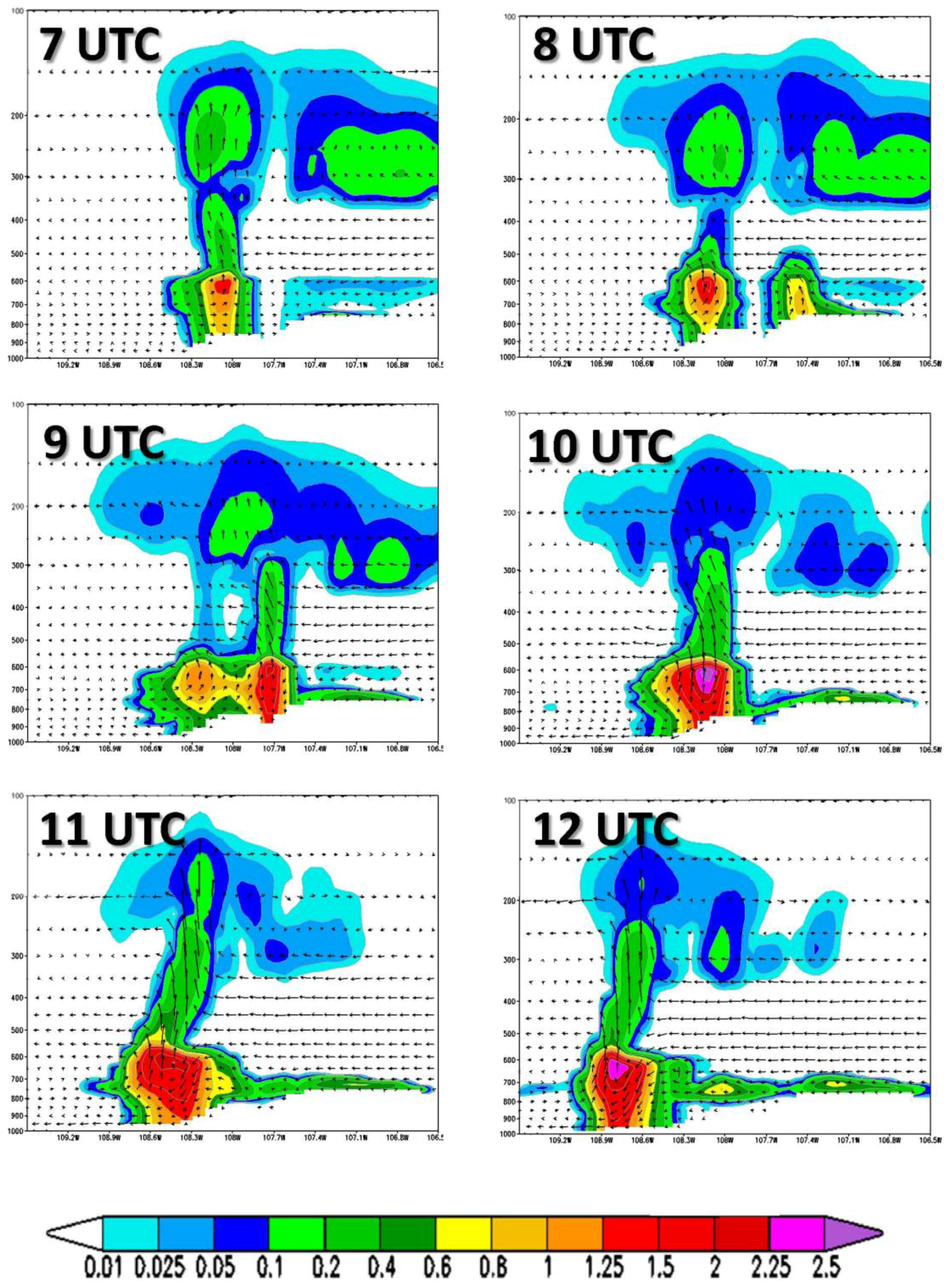
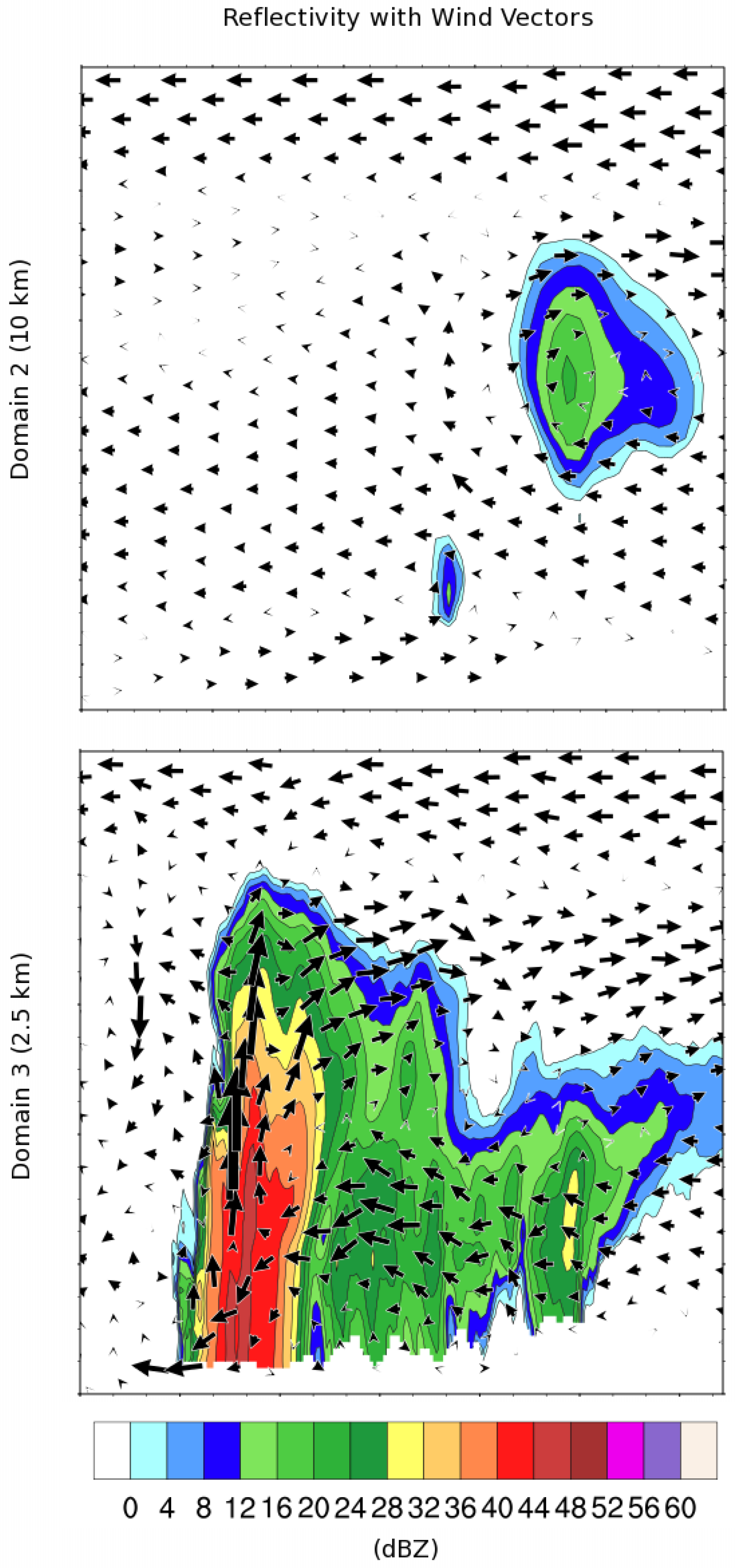
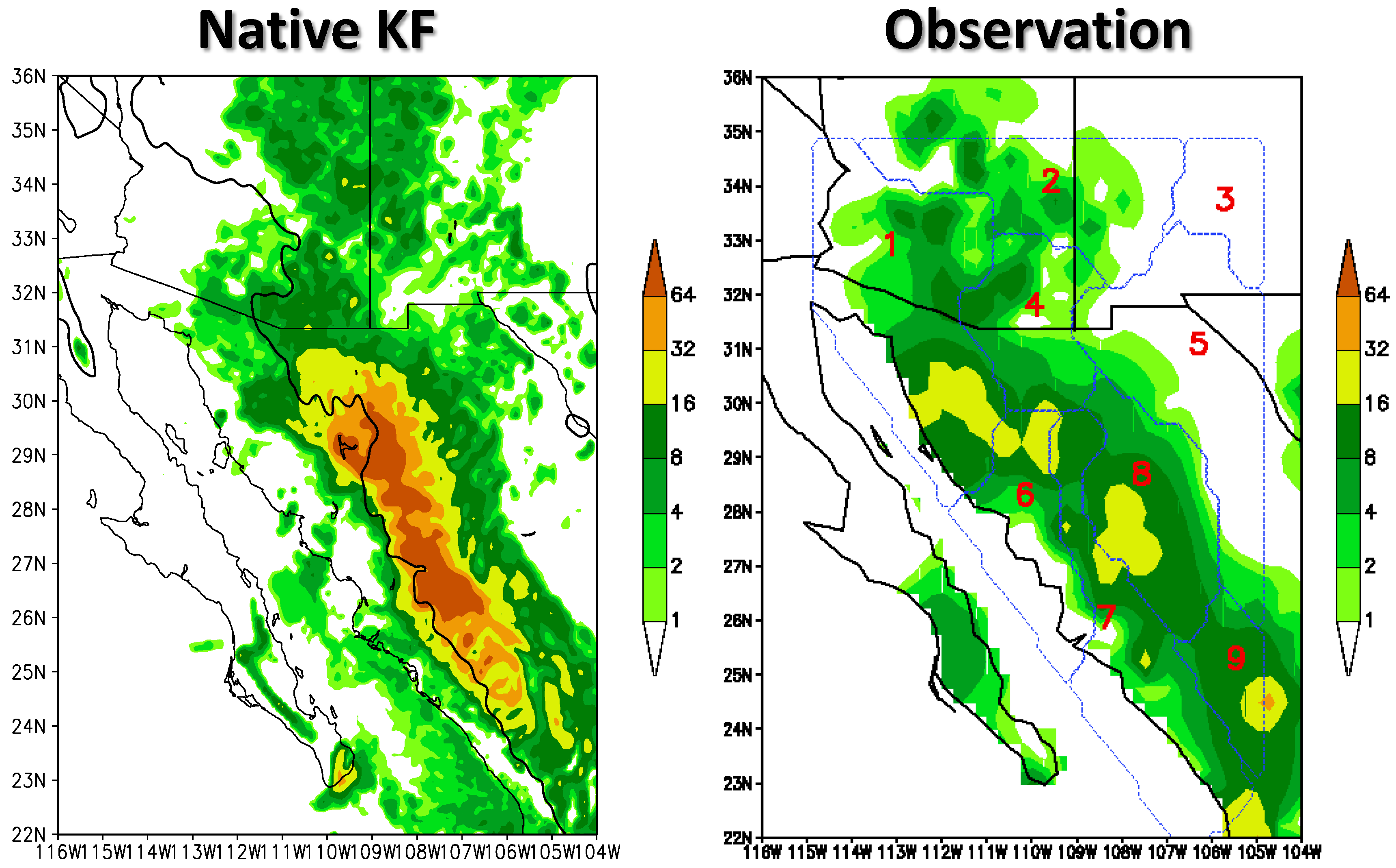
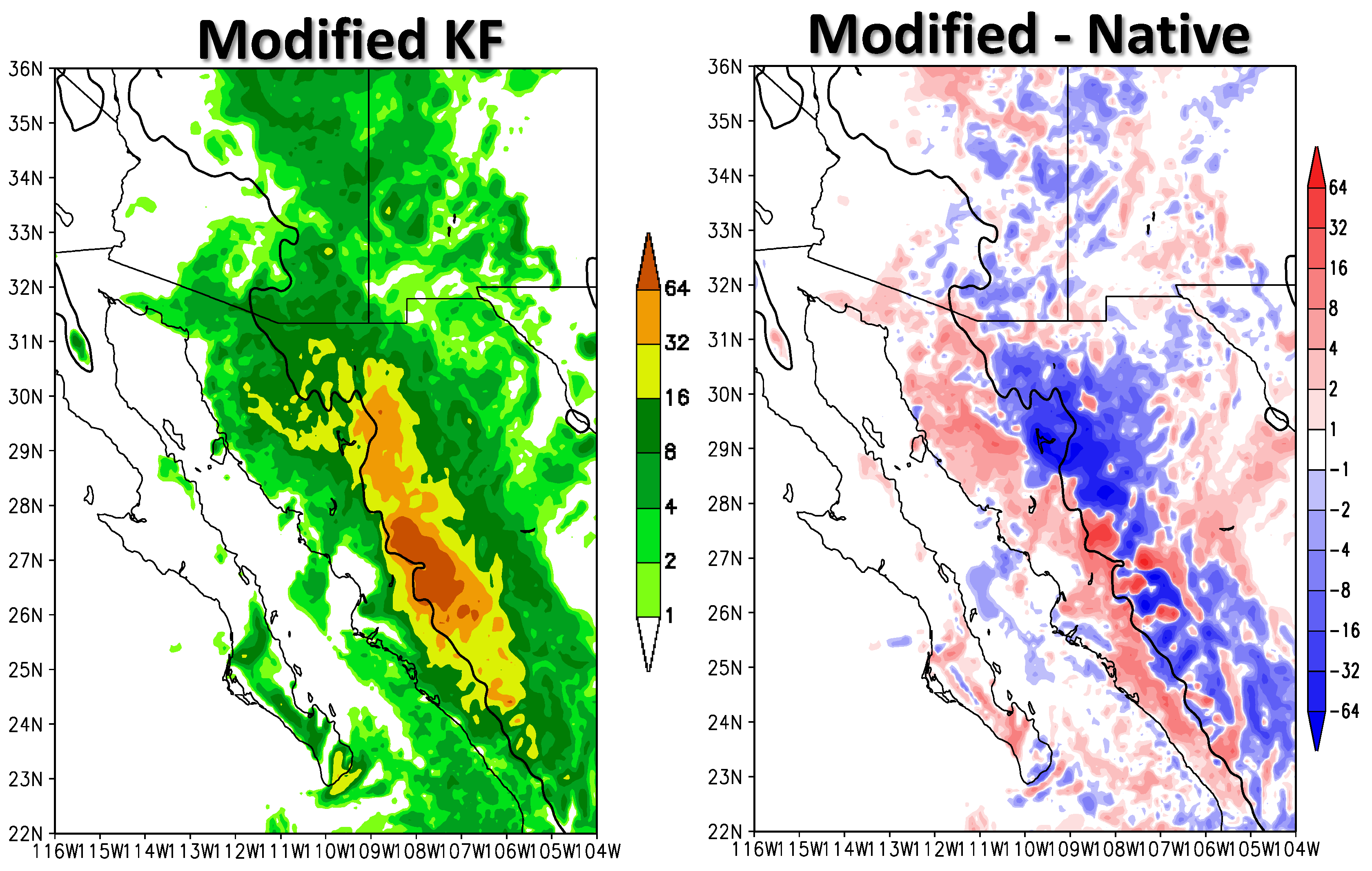
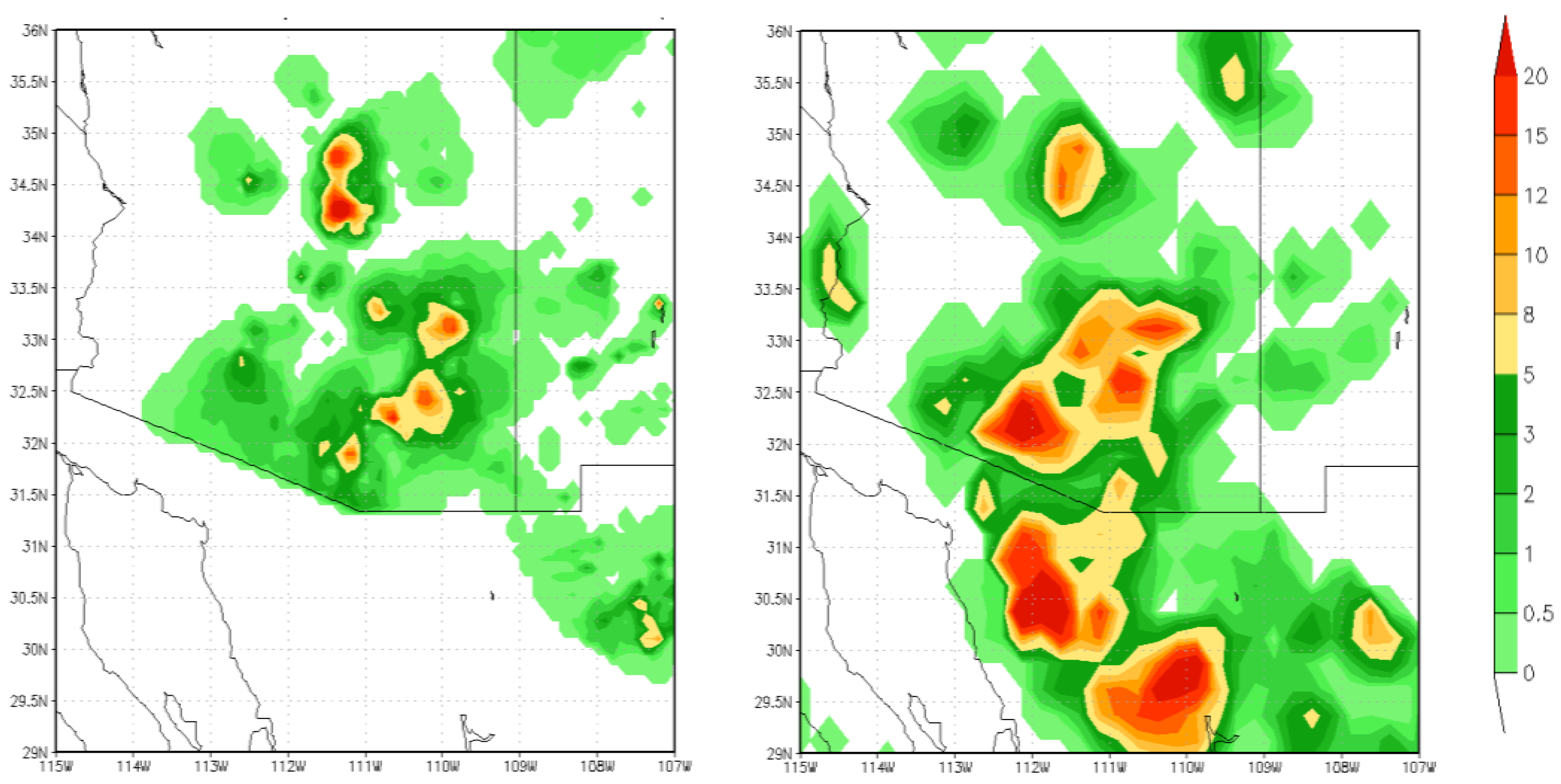
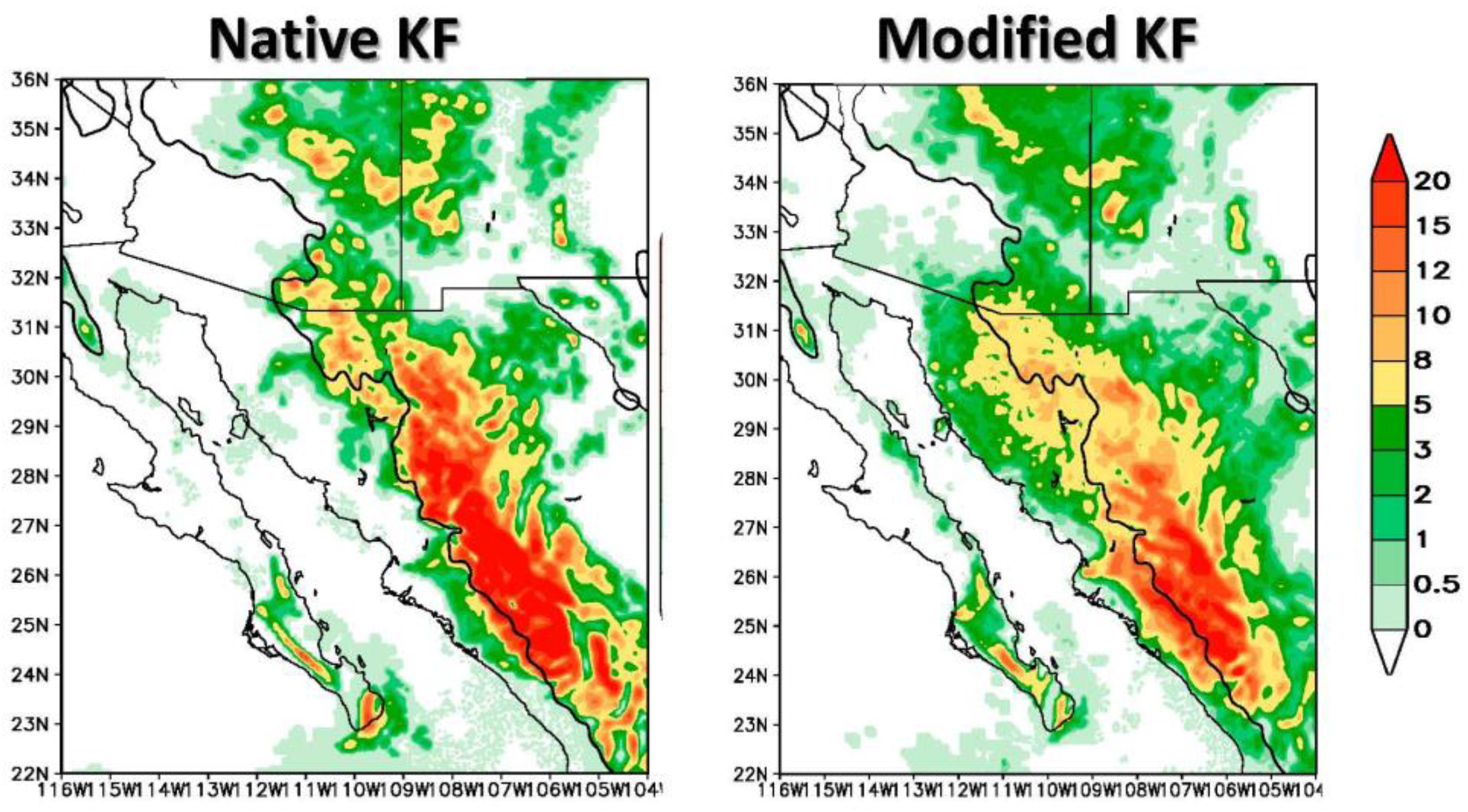
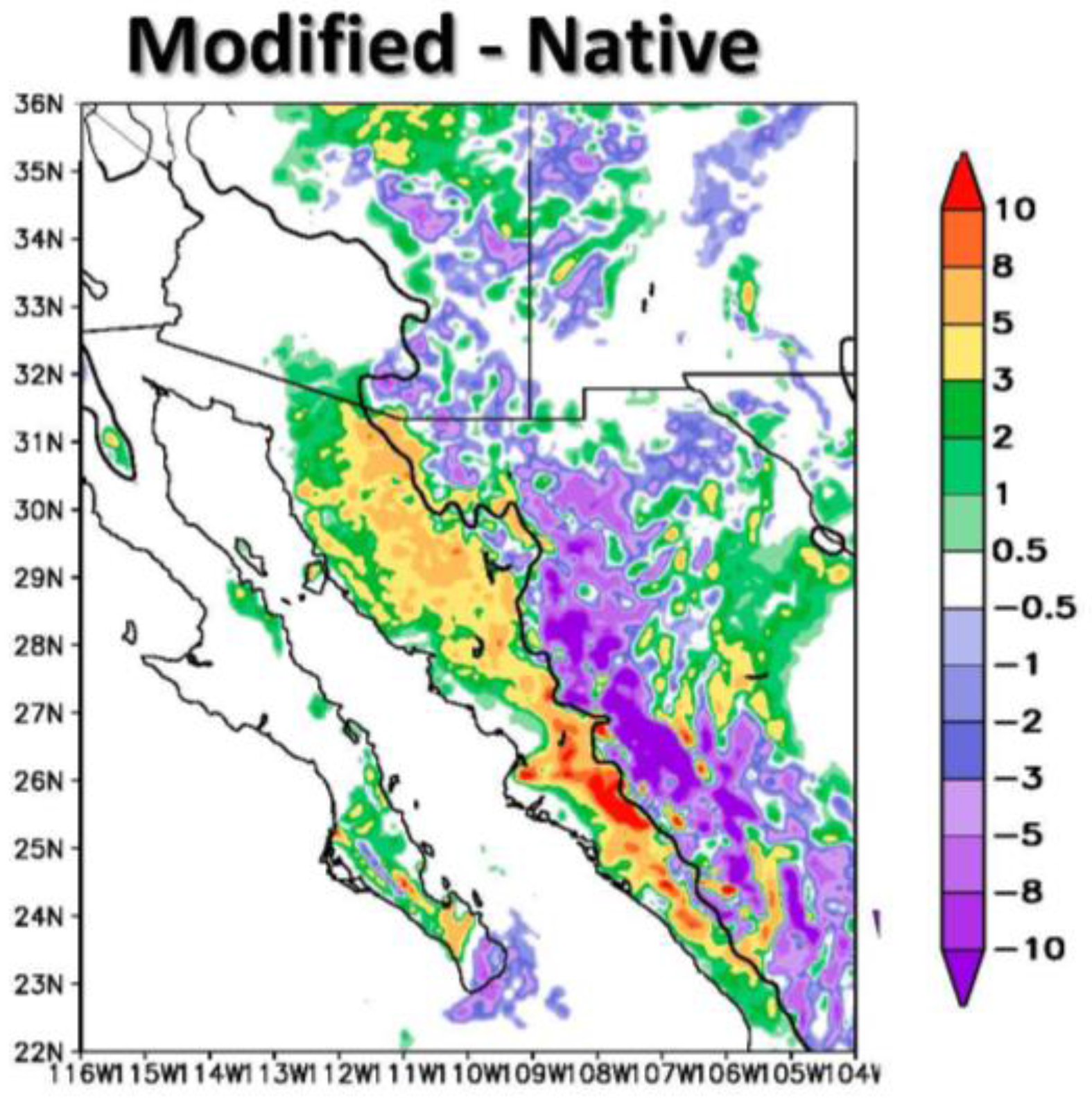
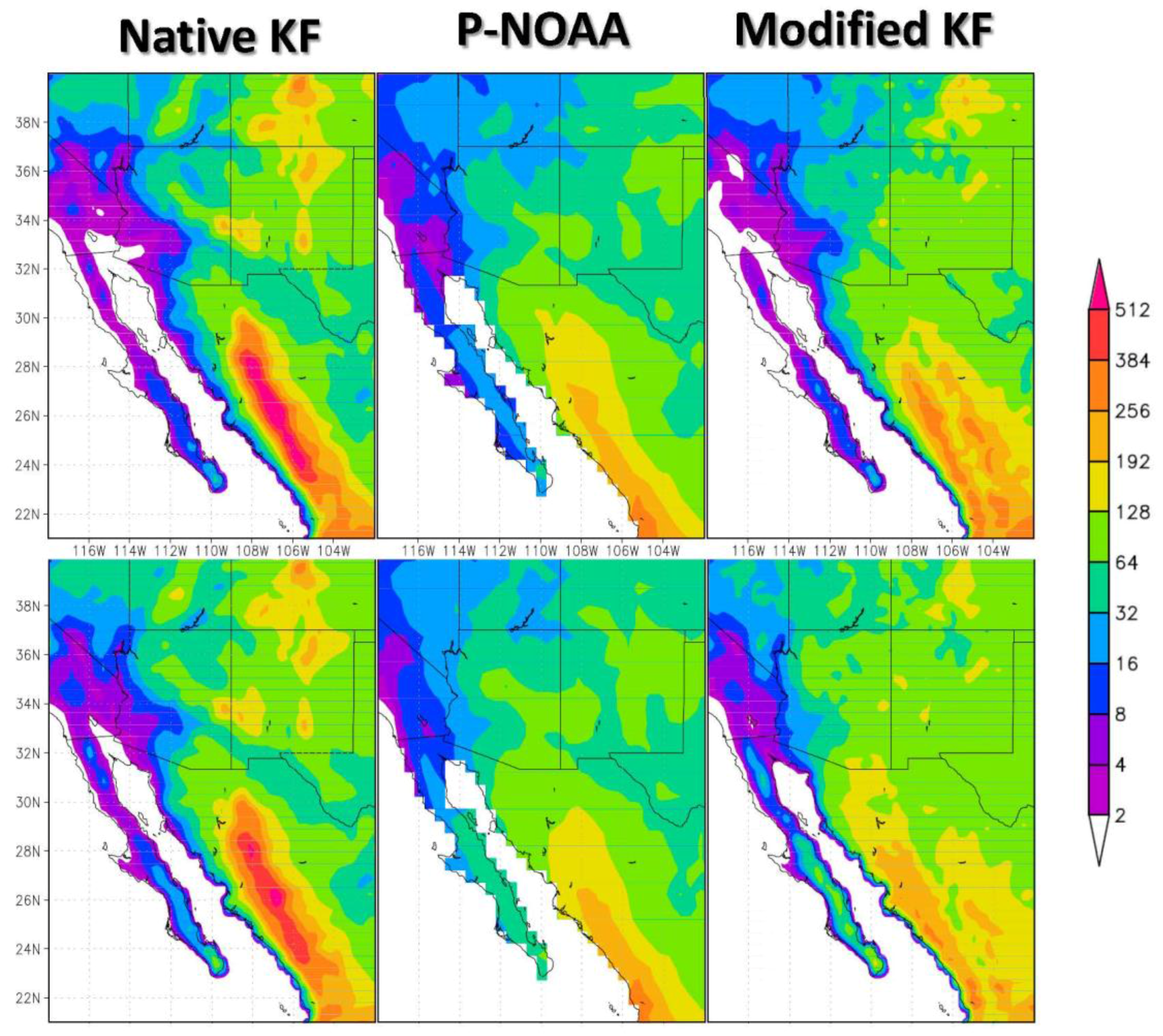
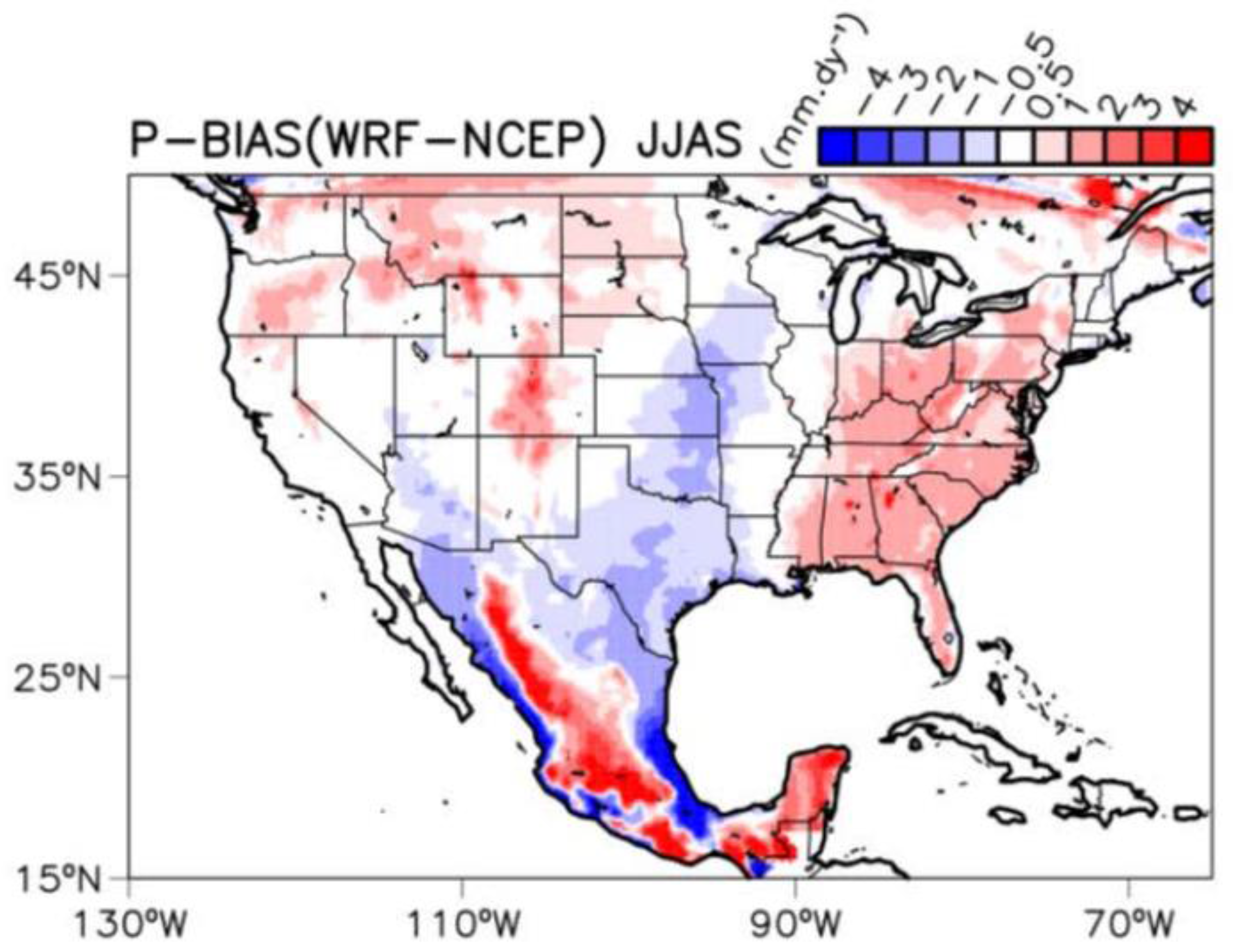
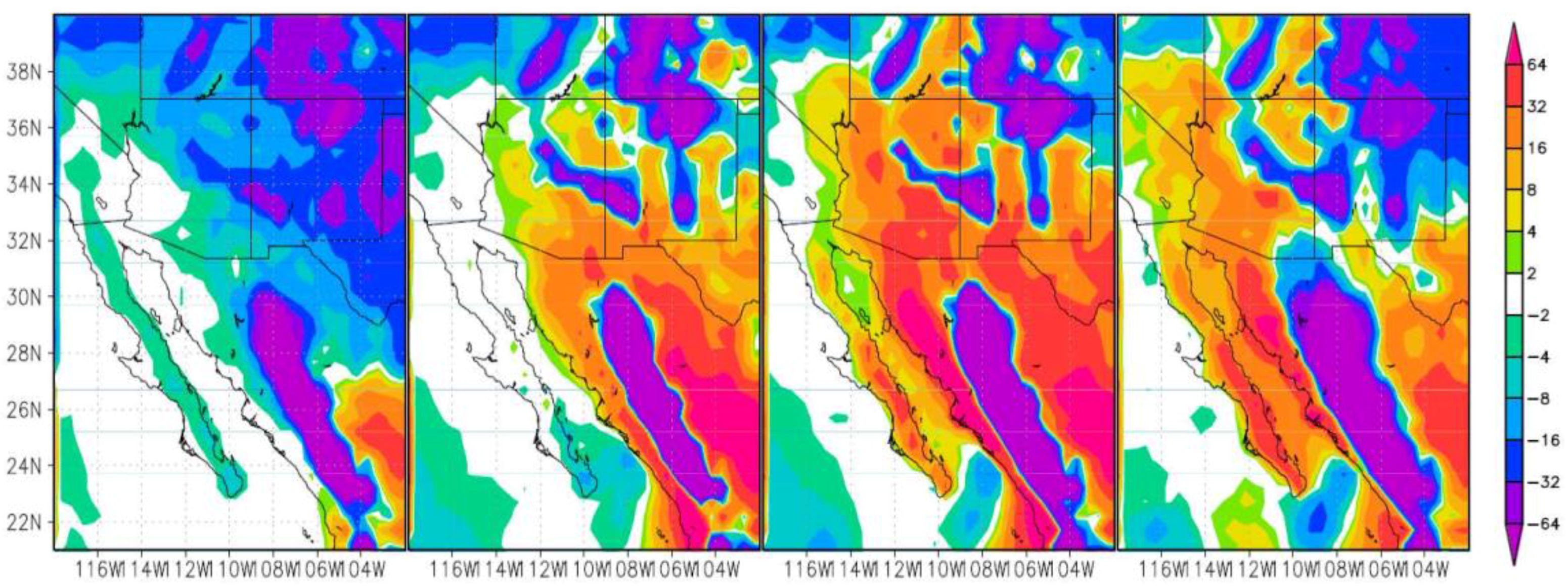
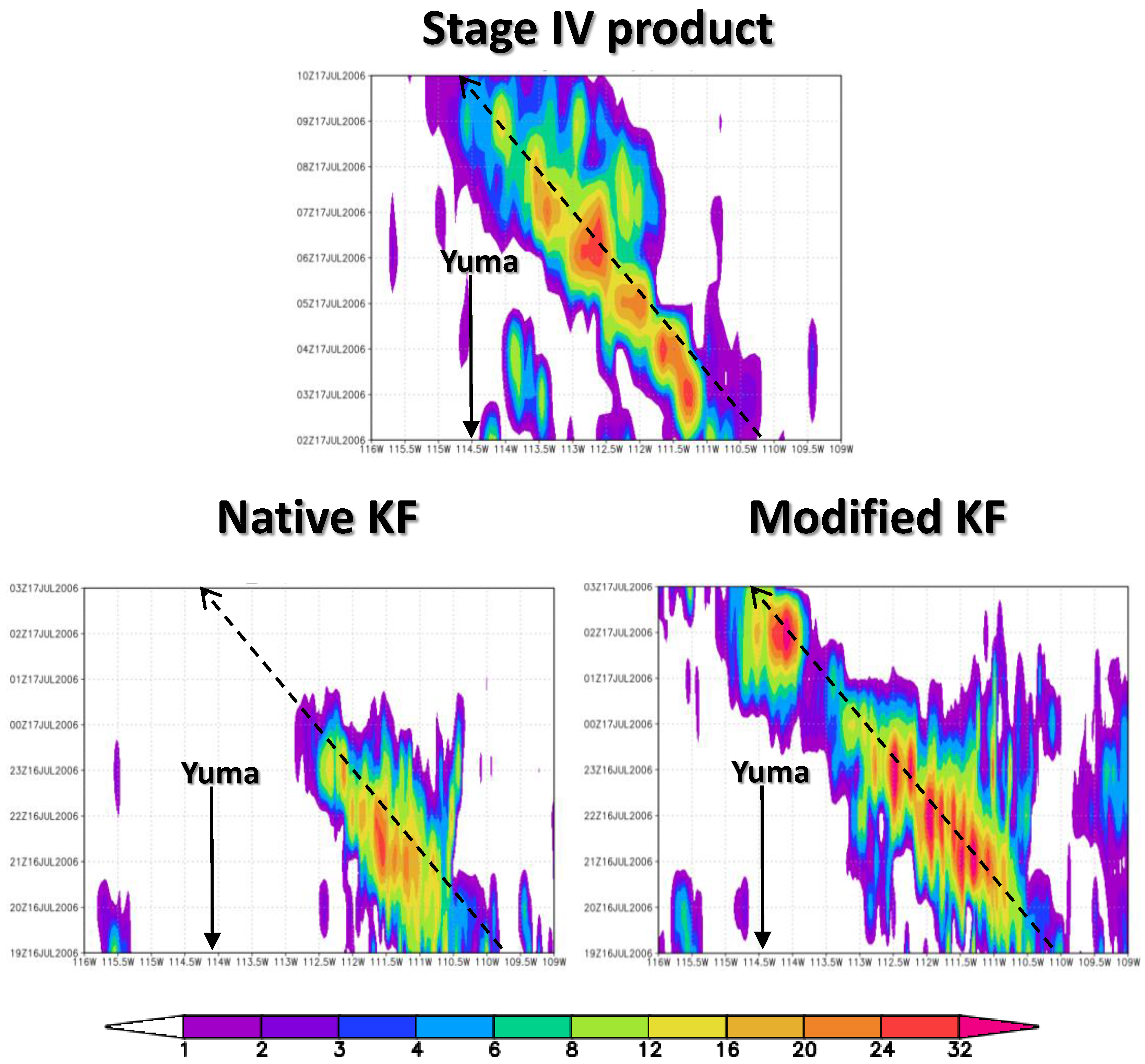
© 2018 by the authors. Licensee MDPI, Basel, Switzerland. This article is an open access article distributed under the terms and conditions of the Creative Commons Attribution (CC BY) license (http://creativecommons.org/licenses/by/4.0/).
Share and Cite
Luong, T.M.; Castro, C.L.; Nguyen, T.M.; Cassell, W.W.; Chang, H.-I. Improvement in the Modeled Representation of North American Monsoon Precipitation Using a Modified Kain–Fritsch Convective Parameterization Scheme. Atmosphere 2018, 9, 31. https://doi.org/10.3390/atmos9010031
Luong TM, Castro CL, Nguyen TM, Cassell WW, Chang H-I. Improvement in the Modeled Representation of North American Monsoon Precipitation Using a Modified Kain–Fritsch Convective Parameterization Scheme. Atmosphere. 2018; 9(1):31. https://doi.org/10.3390/atmos9010031
Chicago/Turabian StyleLuong, Thang M., Christopher L. Castro, Truong M. Nguyen, William W. Cassell, and Hsin-I Chang. 2018. "Improvement in the Modeled Representation of North American Monsoon Precipitation Using a Modified Kain–Fritsch Convective Parameterization Scheme" Atmosphere 9, no. 1: 31. https://doi.org/10.3390/atmos9010031
APA StyleLuong, T. M., Castro, C. L., Nguyen, T. M., Cassell, W. W., & Chang, H.-I. (2018). Improvement in the Modeled Representation of North American Monsoon Precipitation Using a Modified Kain–Fritsch Convective Parameterization Scheme. Atmosphere, 9(1), 31. https://doi.org/10.3390/atmos9010031



